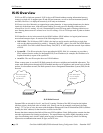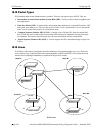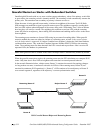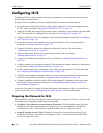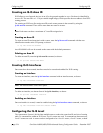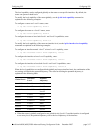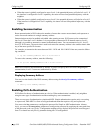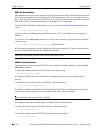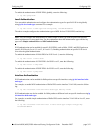
Configuring IS-IS Configuring IS-IS
page 3-14 OmniSwitch 6800/6850/9000 Advanced Routing Configuration Guide December 2007
Configuring IS-IS
Configuring IS-IS on a router requires several steps. Depending on your requirements, you may need to
perform all the steps listed below.
By default, IS-IS is disabled on the router. Configuring IS-IS consists of the following tasks:
• Set up the basics of the IS-IS network by configuring the required VLANs and assigning ports to the
VLANs. This is described in “Preparing the Network for IS-IS” on page 3-14.
• Enable IS-IS. When the image file for advanced routing is installed, you must load the code and enable
IS-IS. The commands for enabling IS-IS are described in “Activating IS-IS” on page 3-15.
• Configure an IS-IS area ID. The commands to create areas and backbones are described in “Creating an
IS-IS Area ID” on page 3-16.
• Create IS-IS interfaces. IS-IS interfaces are created and assigned to areas. Creating interfaces is
described in “Creating an Interface” on page 3-16.
• Configure IS-IS levels. Routers are configured at different IS-IS levels. This is described in
“Configuring the IS-IS Level” on page 3-16.
• Enable summarization. Routes can be summarized on routers. This is described in
“Enabling Summarization” on page 3-18.
• Configure IS-IS authentication (optional). This is described in “Enabling IS-IS Authentication” on
page 3-18.
• Configure interface level parameters (optional). The commands to configure interface level parameters
are described in “Modifying Interface Parameters” on page 3-22.
• Create a redistribution policy and enable the same using route maps (optional). To create route maps,
see “Configuring Redistribution Using Route Maps” on page 3-24.
• Configure router capabilities (optional). There are several commands that influence router operation.
These are covered briefly in the table in “Configuring Router Capabilities” on page 3-30.
• Configure redundant switches for graceful IS-IS restart (optional). Configuring switches with redun-
dant switches for graceful restart is described in “Configuring Redundant Switches in a Stack for
Graceful Restart” on page 3-31.
At the end of the chapter is a simple IS-IS network diagram with instructions on how it was created on a
router-by-router basis. See “IS-IS Application Example” on page 3-32 for more information.
Preparing the Network for IS-IS
IS-IS operates over normal switch functions, using existing ports, virtual ports, VLANs, etc. However, the
following network components should already be configured:
• Configure VLANs that are to be used in the IS-IS network. VLANs should be created for all the
connected devices that will participate in the IS-IS network. VLAN configuration is described in
“Configuring VLANs,” in the OmniSwitch 6800/6850/9000 Network Configuration Guide.
• Assign IP interfaces to the VLANs. IP interfaces or router ports, must be assigned to the VLAN.
Assigning IP interfaces is described in “Configuring VLANs,” in the OmniSwitch 6800/6850/9000
Network Configuration Guide.





